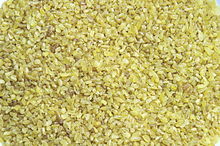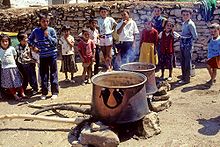Bulgur
This article needs additional citations for verification. (September 2011) |


Bulgur (from Turkish: bulgur;[1] also burghul, from Arabic: برغل[2] groats) is a cereal food made from the groats of several different wheat species, most often from durum wheat. Bulgur is a kind of dried cracked wheat.[3] It is most common in European, Middle Eastern, and Indian cuisine.
Use

| Nutritional value per 100 g (3.5 oz) | |
|---|---|
| Energy | 83 kcal (350 kJ) |
18.58 g | |
| Sugars | 0.10 g |
| Dietary fiber | 4.5 g |
0.24 g | |
3.08 g | |
| Vitamins | Quantity %DV† |
| Vitamin A equiv. | 0% 0.0 μg |
| Vitamin A | 1 IU |
| Thiamine (B1) | 5% 0.057 mg |
| Riboflavin (B2) | 2% 0.028 mg |
| Niacin (B3) | 6% 1.000 mg |
| Vitamin B6 | 5% 0.083 mg |
| Folate (B9) | 5% 18 μg |
| Vitamin C | 0% 0.0 mg |
| Vitamin E | 0% 0.01 mg |
| Minerals | Quantity %DV† |
| Calcium | 1% 10 mg |
| Iron | 5% 0.96 mg |
| Magnesium | 8% 32 mg |
| Phosphorus | 3% 40 mg |
| Potassium | 2% 68 mg |
| Sodium | 0% 5 mg |
| Zinc | 5% 0.57 mg |
| Other constituents | Quantity |
| Water | 78 g |
| †Percentages estimated using US recommendations for adults,[4] except for potassium, which is estimated based on expert recommendation from the National Academies.[5] | |
Bulgur is recognized as a whole grain by the U.S.D.A. and the Whole Grains Council. Bulgur is sometimes confused with cracked wheat, which is crushed wheat grain that has not been parboiled. Whole-grain, high-fiber bulgur and cracked wheat can be found in natural food stores, Middle Eastern specialty grocers, and some traditional grocery stores. Bulgur is a common ingredient in Armenian, Iraqi, Assyrian, Kurdish, Syrian, Israeli, Jordanian, Palestinian, Lebanese, Turkish, Middle Eastern, and Mediterranean dishes. It has a light, nutty flavor. In Turkey, a distinction is made between fine-ground bulgur, called köftelik bulgur, and a coarser grind, called pilavlık bulgur. In the United States, bulgur is produced from white wheat in four distinct grinds or sizes (#1 Fine, #2 Medium, #3 Coarse and #4 Extra Coarse). The highest quality bulgur has particle sizes that are uniform thus allowing a more consistent cooking time and result.
It is also known as "dalia" in North India and Pakistan. Dalia is popular all over the wheat-consuming regions of North India and Pakistan. It can be consumed as sweet dalia or regular dalia.
Bulgur can be used in pilafs, soups, bakery goods, or as stuffing. In breads, it adds a whole grain component. It is a main ingredient in tabbouleh salad and kibbeh. Its high nutritional value makes it a good substitute for rice or couscous. In Indian and Pakistani cuisine, bulgur or daliya is used as a cereal with milk and sugar. In the United States is often used as a side dish, much like pasta or rice. In meals, bulgur is often mistaken for rice because it can be prepared in a similar manner, although it has a texture more like couscous than rice.
In Turkey, bulgur is prepared (using pilavlık bulgur) as pilaf in chicken stock, with or without sauteed noodles, or cooked with tomatoes, onions and red pepper. The fine grind (köftelik bulgur) is used for making kısır, a bulgur salad similar to tabbouleh, prepared with tomato paste, fresh tomatoes, cucumbers, parsley, olive oil, and other salad ingredients to personal taste. Pomegranate molasses (nar ekşisi in Turkish), which is more sour than sweet, is commonly used in favor of lemon juice to add tartness. A variety of mezes and main dishes are prepared with köftelik bulgur, such as çiğ köfte, içli köfte, and ezogelin soup. It also forms the base of a soup, tarhana, which is made with yogurt to which hellim/halloumi has been added.
In Cyprus, it is used to make "κούπες" (also known as bulgur köftesi in Cypriot Turkish), a variety of kibbeh. Its crust is usually made of bulgur wheat, flour, oil, salt and egg, then filled with ground meat (beef and/or pork), onions, parsley and spices. There is also vegetarian "κούπες" which substitutes the ground meat with chopped mushrooms.
The Saudi Arabian version of bulgur, popular in Nejd and Al-Hasa, is known as jarish.[6]
Nutrition facts
Cooked bulgur is composed of 78% water, 19% carbohydrates, and 3% protein (table). In a 100 gram reference amount, it provides 83 Calories.
See also
References
- ^ "Bulgur | Definition of Bulgur by Merriam-Webster". Merriam-webster.com. Retrieved 2015-12-25.
- ^ "Burghul | Define Burghul at Dictionary.com". Dictionary.reference.com. Retrieved 2014-03-20.
- ^ "Bulgur - definition of bulgur by The Free Dictionary". Thefreedictionary.com. Retrieved 2015-12-25.
- ^ United States Food and Drug Administration (2024). "Daily Value on the Nutrition and Supplement Facts Labels". Retrieved 2024-03-28.
- ^ National Academies of Sciences, Engineering, and Medicine; Health and Medicine Division; Food and Nutrition Board; Committee to Review the Dietary Reference Intakes for Sodium and Potassium (2019). Oria, Maria; Harrison, Meghan; Stallings, Virginia A. (eds.). Dietary Reference Intakes for Sodium and Potassium. The National Academies Collection: Reports funded by National Institutes of Health. Washington (DC): National Academies Press (US). ISBN 978-0-309-48834-1. PMID 30844154.
{{cite book}}: CS1 maint: multiple names: authors list (link) - ^ Food from Saudi Arabia

